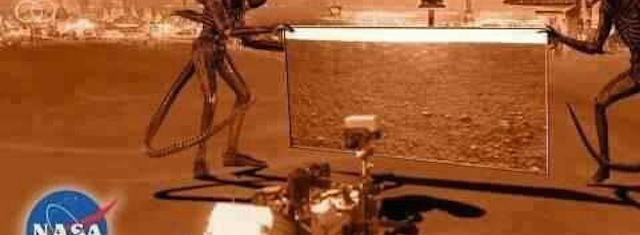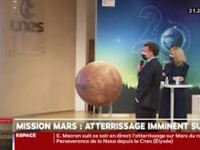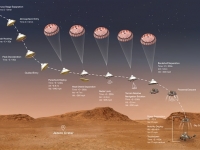Technology
THE MOST ADVANCED ROVER PERSEVERANCE OF NASA HAS LANDED SUCCESUFLLY ON MARS
PDT MACRON & BRIGITTE WATCH LIVE AT CNES

NASA's Perseverance Rover Landing on Mars (Source: NASA)
USPA NEWS -
"NASA works. When we put our arms together and our hands together and our brains together, we can succeed. This is what NASA does. » said chief engineer and landing veteran Rob Manning as he celebrates NASA´s Perseverance ´s successful landing on Mars, today 18 February 2021. This is a historic moment.
In France, President Emmanuel Macron followed live, this Thursday, the landing of the Rover Perseverance, of NASA, on the planet Mars live from the Paris headquarters of CNES, accompanied by his wife Brigitte. The risky landing was a success, around 9.45am in France (CEST). Perseverance, the Rover vehicle, the most advanced and largest ever known by NASA, Perseverance entered the atmosphere of the Red planet, Mars, at a speed of 20,000 km / h, and protected by its heat shield which was only released after the opening of a huge supersonic parachute. The (8) Eight retrorockets then finished slowing it down before deploying by its six wheels, suspended along cables until contact with the ground.
In France, President Emmanuel Macron followed live, this Thursday, the landing of the Rover Perseverance, of NASA, on the planet Mars live from the Paris headquarters of CNES, accompanied by his wife Brigitte. The risky landing was a success, around 9.45am in France (CEST). Perseverance, the Rover vehicle, the most advanced and largest ever known by NASA, Perseverance entered the atmosphere of the Red planet, Mars, at a speed of 20,000 km / h, and protected by its heat shield which was only released after the opening of a huge supersonic parachute. The (8) Eight retrorockets then finished slowing it down before deploying by its six wheels, suspended along cables until contact with the ground.
NASA's ROVER SENDS ITS FIRST TWEET AFTER LANDING ON MARS----------------------------------------------------------Perseverance, NASA´s rover sent its 1st short and powerful tweet after landing on Mars, that says : « I´m safe on Mars. Perseverance will get you anywhere» On the American Homeland´s side, Swati Mohan, in charge of Control Operations chief, exclaimed: "Landing confirmed! ", as she felt proud and accomplished from the EDL War Room of the Jet Propulsion Laboratory, in Pasadena, California, where the team members , NASA, proud, showed their joy loudly.
PERSEVERANCE IS THE EVER MOST ADVANCED ROVER LAUNCHED BY NASA-----------------------------------------
PERSEVERANCE is the 5th American rover, which lands on the soil of the Red Planet, Mars which has attracted and fascinated Earthmen since the dawn of time. Perseverance is only the fifth rover to set foot on Martian soil. Indeed, since the first, NASA launch in 1997, the last Curiosity is still active on the ground of Mars. From now on, the NASA teams will spend the next few days carrying out numerous checks on the advanced equipment for optimal operation. The next step will consist of the first rock samples by Perseverance which should start this summer. Then, the samples will be brought back to Earth in sealed tubes and then brought back to Earth, on the occasion of a future mission, by 2030, for analysis.
PDT MACRON AND HIS WIFE BRIGITTE TO SNES TO SEE LIVE LANDING OF PERSEVERANCE ON MARS--------
Emmanuel Macron went to the Paris headquarters of the Center National d'Etudes spatiales (CNES) this evening, watching live, on Thursday evening, to witness the risky landing of NASA's Perseverance rover on Mars, partially equipped with French instruments, according to the Elysee administration.. President Macron, accompanied by his wife Brigitte Macron, will also meet by videoconference with astronaut Thomas Pesquet, currently in the midst of preparations in the United States for his second flight, in April, to the International Space Station (ISS). The French head of State Emmanuel Macron outlined cohesion and teamwork to scientists on Perseverance: "It´s wonderful teamwork, you can really be proud ». Indeed, this mission to Mars is the fruit of international cooperation: France has designed one of the rover's many scientific instruments, thanks to the participation of the National Center for Space Studies (CNES).
NASA's CURIOSITY ROVER REACHES ITS 3,000th DAY ON MARS-------------------------------------------------------------
It´s been 3,000 Martian days, or sols, since Curiosity touched down on Mars on Aug. 6, 2012, and the rover keeps making new discoveries during its gradual climb up Mount Sharp, the 3-mile-tall (5-kilometer-tall) mountain it has been exploring since 2014. Geologists were intrigued to see a series of rock “benches“ in the most recent panorama from the mission.
Stitched together from 122 images taken on Nov. 18, 2020, the mission´s 2,946th sol, the panorama was captured by the Mast Camera, or Mastcam, which serves as the rover´s main “eyes.“ Toward the center of the panorama is the floor of Gale Crater, the 96-mile-wide (154 kilometer-wide) bowl that Mount Sharp sits within. On the horizon is the north crater rim. To the right is the upper part of Mount Sharp, which has rock layers that were shaped by lakes and streams billions of years ago.
The curved rock terraces that define the area can form when there are harder and softer layers of rock on a slope. As the softer layers erode, the harder layers form small cliffs, leaving behind the benchlike formations. They can also form during a landslide, when huge, curved slabs of bedrock slide downhill. Curiosity´s team has seen benches before in Gale Crater, but rarely forming such a scenic grouping of steps.“Our science team is excited to figure out how they formed and what they mean for the ancient environment within Gale,“ said Curiosity´s project scientist, Ashwin Vasavada of NASA´s Jet Propulsion Laboratory in Southern California, which built and manages the rover.------------------------------------------------------------------
But don´t expect a rover this busy to stay put: Soon after capturing the new panorama, it was off for higher ground. This year, the rover has been driving across a clay-bearing region called “Glen Torridon.“ After making a pit stop at a location nicknamed “ Mary Anning“ it´s continued toward the next major layer, called “ the sulfate bearing unit“ (Source : NASA).
Rahma Sophia Rachdi Jedi Foster Perseverance March Astronaut Thomas Pesquet French Pdt Emmanuel Macron Us Pdt Joe Biden Steve Jurczyk Acting Administrator Pdt Jean-yves Le Gall France Center Of Spatial Studies Cnes Mars Perseverance Nasa
Liability for this article lies with the author, who also holds the copyright. Editorial content from USPA may be quoted on other websites as long as the quote comprises no more than 5% of the entire text, is marked as such and the source is named (via hyperlink).








